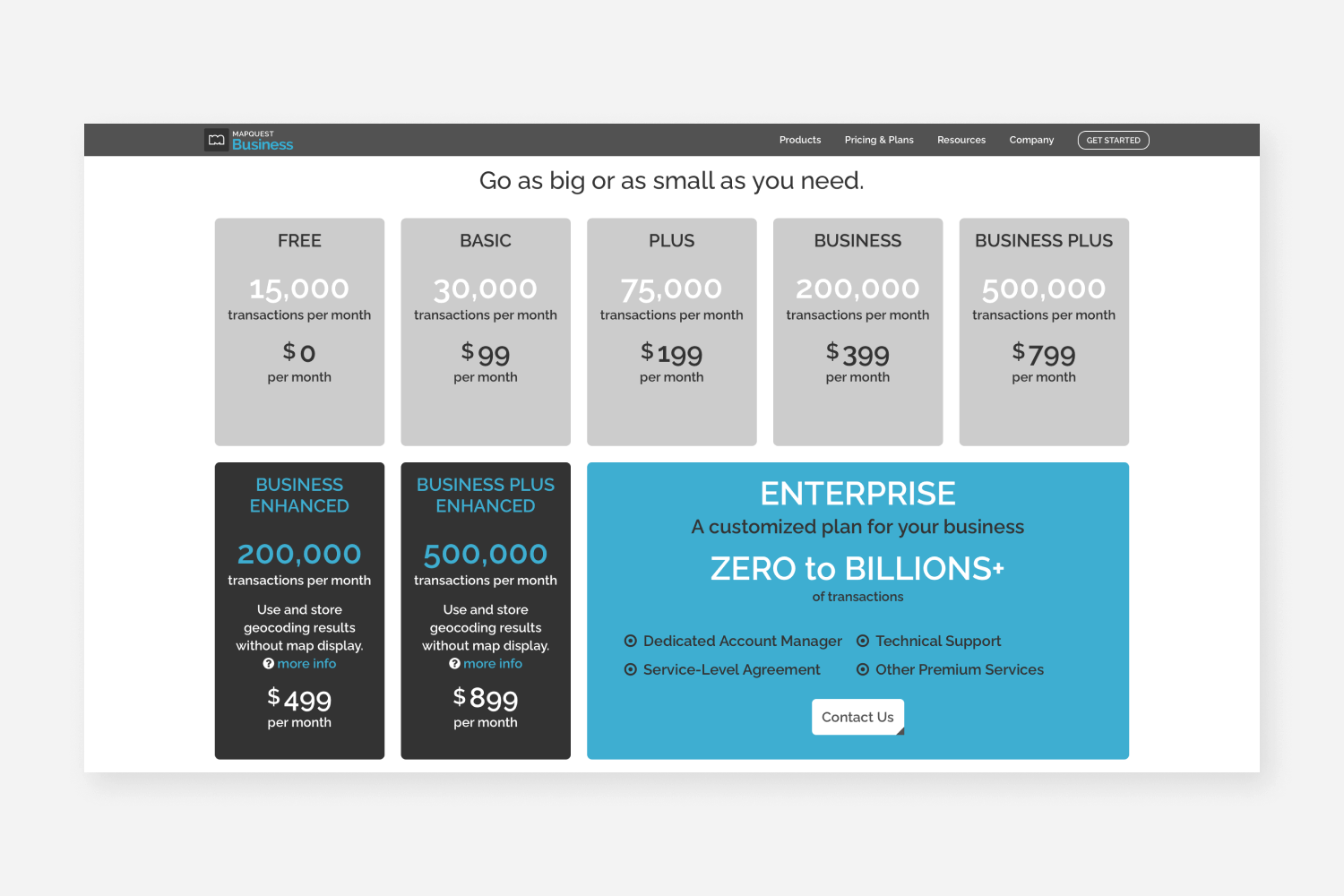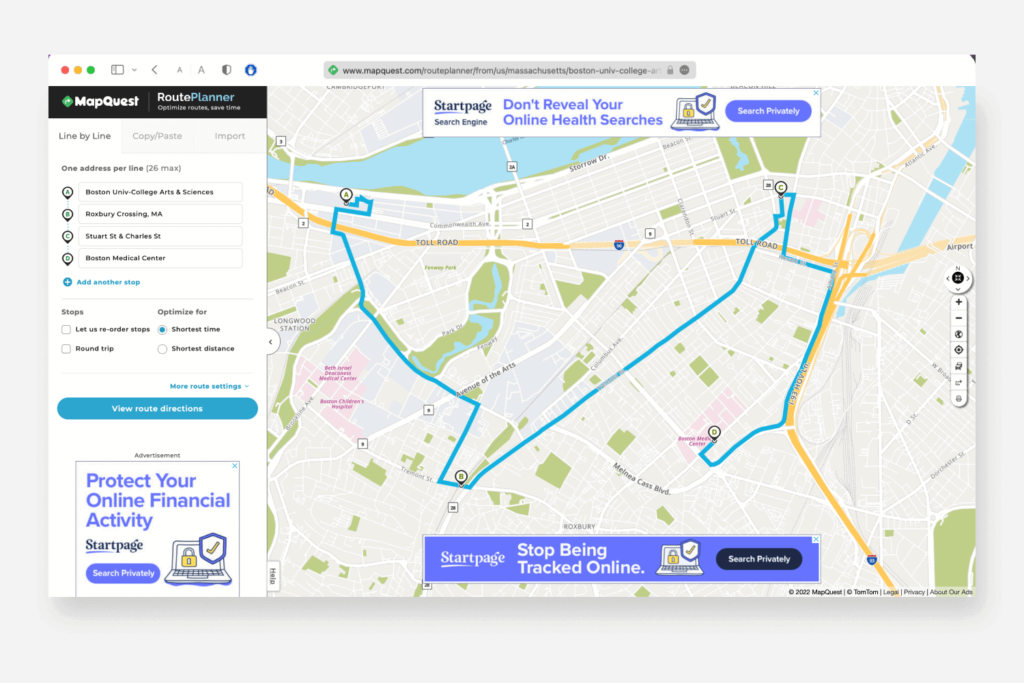A Complete Guide to MapQuest Route Planner

MapQuest has been around for over two decades, and it is still used today when someone needs to map a basic route from one location to another. While the tool has limitations for business use, it can be effective, depending on what features you need.
If you’re looking for route planning software and want to know if MapQuest is the right solution, we’ve got you covered with a head-to-toe overview of its core features, pricing structure, and a step-by-step tutorial.
To navigate to the content most relevant to you, see below:
- What Happened to MapQuest Driving Directions?
- Is MapQuest Route Planner Free?
- How to Use MapQuest Route Planner
- How to Use Mapquest Mileage Calculator
What Happened to MapQuest Driving Directions?
With Google Maps named the #1 most downloaded mapping app in the United States in 2021 and Apple Maps pre-installed on over a billion Apple devices, you might be surprised to learn that the first commercial web mapping service, MapQuest, is still on the market.
After all, we’re talking about the days before Waze driving directions were ubiquitous and even before you could get driving directions Yahoo provided. Back then, free mapping software was novel technology. Now, you can’t go anywhere without it.
But are there any good reasons to use MapQuest over some of its newer competitors? Here are some of the key features of Google Maps, Apple Maps, and MapQuest, so you can see how they stack up against each other and other route-planning solutions.
Key features of Google Maps
Google Maps is one of the most popular mapping tools in the world. Although primarily used recreationally, it’s also used by some small businesses that don’t need a comprehensive suite of route planning options. Here are some of the main features it offers:
- Add up to ten stops
- Easy hands-free navigation
- Real time location sharing
- Add stops along the way of your route while navigating
- Google Street View
- Send maps from your desktop to your car or phone
- Time-specific traffic estimates
- Find parking information before you arrive
- Get exact measurement distances between locations
One of the drawbacks of Google Maps regarding route planning is its lack of cost calculation. Most logistics and delivery-based businesses that are concerned with minimizing expenses and maximizing profits will miss this critical feature.
Key features of Apple Maps
Many people use Apple Maps primarily because it’s pre-installed on every iPhone, iPad, and MacBook. It’s typically considered a personal mapping app rather than a business route planning solution. Here are some of its main features:
- Add up to fourteen stops
- Smooth usage across your Apple devices
- Siri integration for voice control
- Three-dimensional map view
- Road details like turn lanes, medians, bus and taxi lanes, and crosswalks
- Speed and red light camera alerts
- Share ETA with others with a tap or Siri voice command
- Indoor maps for hubs like airports or malls
Apple Maps recently added the ability to add multiple stops to a route, a fairly essential feature in route planning. However, adding multiple stops isn’t as simple as other map planning software. Businesses may find Apple Maps’ features lacking in both time and planning efficiencies.
Key features of MapQuest
Despite being one of the lesser-used mapping solutions, MapQuest offers many similar features to Google Maps and Apple Maps. There are free driving directions in MapQuest, and you can map multiple stops. While it doesn’t compare with what dedicated route planning solutions can offer, here’s what users can do with MapQuest:
- Plan up to 26 stops for free
- Get total estimated fuel costs for a trip
- Save entire routes
- Rearrange multiple destinations
- Avoid toll roads, highways, or seasonal roads
- Automatic IRS reimbursement calculations
- One-tap location-finding (in the mobile app)
- Add stops line-by-line, with copy/paste, or by importing a spreadsheet
Much like Google Maps and Apple Maps, MapQuest is straightforward and effective for simple routes. While it leaves much to be desired for more business route planning, features like its automatic IRS reimbursement calculations are a nice touch. MapQuest will automatically calculate your mileage and translate that into the total reimbursement value you’re entitled to for every trip.
The bottom line
Businesses can use these tools for mapping a route, but that doesn’t necessarily mean they should. True route planning for a business is much more than plotting destinations on a map, as there are many factors to be considered, like driver availability and mandated break times. Even just a simple business case of having more than one driver is too complex of a challenge for a free tool like MapQuest.
Is MapQuest Route Planner Free?

Yes. The MapQuest free route planner lets you plan up to 26 different stops. The free plan also allows 15,000 transactions every month, which might be sufficient for average users. It also has six paid tier plans, ranging from $99/month to $899/month, with transaction capacities between 30,000 and 500,000.
The top-tier enterprise plan includes priority support, a dedicated account manager, and a service-level agreement. It also offers custom pricing and up to billions of transactions—making it more suitable for high-volume users. The downside is that MapQuest’s enterprise pricing is on the high end compared to other route planning software on the market, yet it doesn’t offer nearly as many features, making it nowhere near the same dollar-to-dollar value.
Paid MapQuest users can generate multiple AppKeys for their accounts. However, every device using an AppKey from the same account will count toward the monthly transaction limit. That means transactions can add up quickly if you have a fleet of vehicles.
MapQuest also has a decent selection of APIs and SDKs for developers who want to improve upon the underlying software. You need an account to use MapQuest’s API and SDK library, but it’s available on all tiers.
All that being said, the main difference between the free and paid tier plans is the total number of transactions per month. If MapQuest’s current functionality fails to meet the needs of your business, purchasing a higher-paid tier plan won’t fix it.
How to Use MapQuest Route Planner

Using the MapQuest route planner is intuitive regardless of your device. Here are five easy steps to plan your route with MapQuest:
Step 1. Open MapQuest
Navigate to the MapQuest route planner by visiting the MapQuest website, clicking the menu icon, and then clicking Route Planner. You can do this with any device with an internet connection, including your desktop computer. You can also use MapQuest’s mobile app. The desktop and mobile apps’ simple interface makes the tool easy to use regardless of how tech-savvy you are.
Step 2. Enter addresses
MapQuest’s route planner software offers three different options for address entry:
- Line-by-Line. Type in the addresses on each line, add new stops, and optimize for the shortest distance or quickest arrival time.
- Copy/Paste. Copy and paste up to 26 addresses at once to save time when planning your route.
- Import. Import addresses from a CSV, XLS, or XLSX file format. You can also download template files for future use. Regardless of your method, ensure your addresses are formatted correctly to get an accurate route plan from MapQuest.
MapQuest lets users add up to 26 stops on a single route plan in contrast to Google Maps’ ten and Apple Maps’ fourteen.
A higher waypoint capacity is especially useful for those in the food delivery, eCommerce logistics, and service technician industries. From a cost perspective, adding more stops to each route will help you stay within the transaction limit of your subscription but may not be as convenient as you’d like.
While it offers a delivery route planner for free, businesses requiring more flexibility may hit their limits sooner than expected. They will likely want to investigate dedicated route planning solutions that are more purposefully built for field service and delivery-based businesses. There are solutions available that allow many more stops (as in thousands more) than the free tools on the market.
Step 3. Customize
Click on “More Route Settings” to access other options to help you tailor the route to your preferences. MapQuest can even help you avoid toll roads, ferries, country borders, and other inconveniences.
MapQuest can also accommodate users traveling on foot for short journeys or last mile deliveries. Its walking directions are as accurate and easy to use as its driving directions.
Unlike most navigation tools that optimize for either time or distance, MapQuest gives its users the freedom to choose.
For more customization, you can also reorder stops on the MapQuest multi stop route planner or enable the round-trip checkbox. You need to do this manually in MapQuest, but it can cost time and fuel efficiencies.
MapQuest’s automation capabilities can help you find the most efficient route for thousands of trips. This may be sufficient if you are using it for personal travel, or if you have very limited business needs. However, it doesn’t consider the time spent at each stop, time window or other special requirements, driver skills, and other key factors that come standard in more advanced route planning solutions intended for business use.
Step 4. View directions
Once you’re happy with the stops and settings, click “View Route Directions” to see your full route. The route planner displays a list of step-by-step directions along with the total distance of your route, the estimated travel time, and the IRS reimbursement value of your trip.
Step 5. Share
You can share these directions through email, links, or mobile numbers. Alternatively, you can print out your route plan. Simply click on the “Print” icon at the top of the page to create a hard copy of the itinerary. You can also choose to have your driving directions in words along with the map image.
How to Use MapQuest Mileage Calculator
Fuel efficiency is important for every driver, but knowing the mileage of upcoming trips is especially crucial for workers that want to expense their fuel costs while on a business trip.
That makes MapQuest’s mileage calculators for the USA one of its more interesting features. It allows users in the United States to get an IRS reimbursement rate calculation for any route created in MapQuest.
The values calculated are based on the current year’s official IRS reimbursement rate, which is a cent per mile figure. MapQuest calculates the reimbursement value by multiplying the number of miles on your route by the rate supplied by the IRS.
You’ll need to enable this tool to calculate your IRS reimbursement rate. Here is the step-by-step process to do that:
- Visit the MapQuest directions page on their website.
- Click “Route Settings”
- Toggle the switch next to “Use IRS Reimbursement for Fuel” to the right
- Click Apply Settings
After completing these steps, you should see an IRS reimbursement value when you map a route and also on the Route Options page. You’ll need to click “View Step-by-step Directions” to see the value.
Conclusion
Maybe you thought MapQuest was a relic from the early internet days like AOL or MySpace, but it still exists. It offers similar features to Google Maps and Apple Maps, including finding the shortest route and evading costly toll fees. Its ability to calculate an IRS reimbursement value for your business trips is also a nice touch. MapQuest is a fine option for recreational use, like road trips or planning a single business trip route, but it’s no secret that it can’t quite keep up with route planning and true route optimization software. It only offers a few features that logistics and smaller businesses rely on when planning routes and cannot find an optimal route based on more than simple distance. While MapQuest can work for some business cases, like visiting a single work location, you may be better off using a full-service route planning solution.
Try OptimoRoute™ for Free
No installation or credit card required


